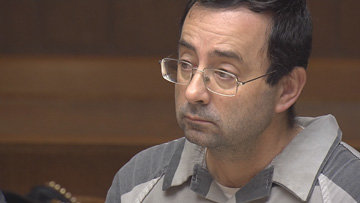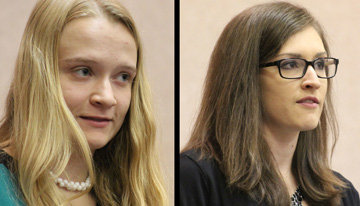
But The Nassar case is only an extreme example of the ongoing crisis of sexual assault and harassment plaguing MSU. It also serves as a microcosm on how the university responds to the allegations: often playing catch up to the news and never getting in front of the stories; responding to sexual assault and harassment in ways that appear to be more about covering up the incidents than fully airing them; and tainting the university’s sports teams and athletic department with perceptions that the whole department and the players are complicit in the ongoing crisis.

In fact, the university has been under scrutiny by activists and the federal government for its handling — or lack thereof— of sexual assault on the campus for years. It has rarely made headlines and barely pricked the conscience of the American news consumers — until the case of Nassar came along.
MSU President Lou Anna Simon told the Board of Trustees in February, "There is no culture of tolerance of sexual assault or harassment." But she admitted much work remains to be done when she also said, "We are committed to creating a culture of accountability, safety and responsiveness regarding sexual assault and harassment."
Simon declined requests to be interviewed for this story.
While MSU has made strides in reducing the wait times for investigations and increased the number of investigators on hand; experts and lawyers say the university has a long way to go to achieve Simon’s “no culture of tolerance.”
“It's certainly not demonstrated in any of the information or from any of the people that I've talked to that there is any measure of protection,” said David Mittleman, an attorney with Grewal law firm of Okemos who is representing victims of Nassar in civil suits.
California attorney Alex Zalkin, who represents four women who are suing MSU, concurs with Mittleman’s assessment. And he provides a possible motivation for the university’s slow responses: the university’s reputation.
“No university wants to be known as the rape university,” he said in a phone interview.
Experts, lawyers and lawmakers interviewed for this story highlighted some of MSU’s continued struggles to address the on-going crisis — a lack of counseling services and immediate availability for survivors of sexual assault; a strict reading of federal privacy laws that prevent full transparency on who is accused of sexual assault and harassment and why they received a specific punishment; and a failed understanding of consent in sexual activities.
A Blemished History
MSU is not alone in struggling with how to address sexual assault. With the high profile case of Nassar in the headlines, the university had joined the scandal ranks of Baylor University and Penn State. But that case is only the most recent — and horrific — example of the ongoing crisis and MSU’s struggle to address the epidemic.
The university’s recent history of trying to address the crisis dates back to August 2010. That’s when a woman accused two freshmen basketball players of sexually assaulting her in a dorm room on campus. Classes had not yet begun, and the two men and the woman met and socialized. There was drinking. There was strip basketball in the men’s dorm room. Then came the sexual assault.
She filed a criminal complaint, which was investigated by MSU and turned over to former Ingham County Prosecutor Stuart Dunnings III. Dunnings refused to bring charges, and that triggered protests against the university and the prosecutor’s office. Dunnings released a transcript of the interview with one of the accused players. He appears to admit the woman tried to stop the sexual activity but the men kept going.
The survivor of the attack filed a complaint with the U.S. Education Department's Office of Civil Rights alleging MSU had failed to properly investigate her claims against the players. That complaint, and another, triggered a large-scale investigation by the federal agency in 2014 and 2015. Federal investigators found that MSU had failed to investigate the claims in a timely manner.
Those investigators also found the university had failed to properly and timely investigate other allegation of sexual assault.
The final investigative report in September 2015 found the university had failed in numerous instances to respond in a timely manner to allegations of sexual assault and harassment and determined “a sexually hostile environment existed for and affected numerous students and staff on campus at the University,” and “that the University’s failure to address complaints of sexual harassment, including sexual violence, in a prompt and equitable manner caused and may have contributed to a continuation of this sexually hostile environment.”
In August 2015 MSU signed an agreement with the Office of Civil Rights to substantially change its handling of sexual harassment and assault on campus. The university agreed to change parts of its policy, beef up investigatory processes and increase the amount of trainings provided to students, staff and MSU police.
But even as MSU was inking the deal with federal officials, allegations were beginning to bubble up against Nassar. A 2014 investigation into claims he sexually assaulted a woman during a medical exam cleared him, but it also contained specific rules by which he was to conduct himself during future exams. In September 2016, MSU learned that Nassar had failed to fulfill some of those rules, including wearing gloves during vaginal and anal exams and failing to have another person in the room during such exams. The cost Nassar his job. Since then, the number of women and girls accusing Nassar of sexually assaulting them is now at least 100. He faces more than two dozen state charges for his alleged conduct and federal charges related to possession of tens of thousands of images of child pornography.
Last week, the University’s Office of Institutional Equity, which conducts investigations into allegations of violations of the MSU sexual harassment policy, released a report concluding that on at least one occasion, Nassar had sexually assaulted a woman.
Michigan Attorney General Bill Schuette has publicly called Nassar “a monster.” Every week there is another revelation in the case implicating staff and employees of the university. It is alleged they knew of Nassar’s actions and that some attempted to dissuade victims from coming forward. MSU Dr. Brooke Lemmen, who helped clear Nassar of a sexual harassment policy violation in 2014, resigned after MSU said it had found she had removed an unknown number of confidential patient files at Nassar’s behest.
Attorneys for the Nassar victims say the case is “bigger than Penn State,” referring to child sexual abuse committed by assistant football coach Jerry Sandusky.
Even as the Nassar case continues to unfold through criminal and civil cases, the university was rocked in February when three unidentified football players were suspended from the team and booted from university housing over allegations they sexually assaulted a woman. A staff member of the football team was also suspended from his post in the wake of the allegations.
Ingham County Prosecutor Carol Siemon continues to review the police reports to determine what, if any, criminal charges will come of the allegations against the football players; the Michigan State University Office of Institutional Equity is coming up on a 60-day deadline to complete its investigation into possible violations of the school's policy on relationship violence and sexual harassment.
Besides four civil suits filed thus far against MSU over Nassar, there is the unrelated suit four women have brought alleging the university has failed to adequately respond to sexual assault.
The suit names the Board of Trustees; Denise Maybank, the vice president of student affairs; and President Simon. It also named Kappa Sigma Fraternity, but it was dismissed.
The 26-page federal complaint, filed in the federal Western District Court in Grand Rapids, alleges MSU failed to respond appropriately and in a timely manner to complaints of sexual assault. Two of the women chose to be identified in the lawsuit, Emily Kollaritsch and Shayna Gross. The two other women are referred to in court records as Jane Roe 1 and Jane Roe 2.
“The utter lack of immediate and adequate response by MSU officials to these and other complaints of sexual violence experienced by its students is reprehensible,” said their attorney, Alex Zalkin.
Ramped-up Investigations
Jessica Norris, the Title IX coordinator for the university, told a gathering of about 20 people on Thursday that her office has expanded since 2015.
She said the office had three investigators in 2015. (The U.S. Education Department said two.) As of January, the office has nine. The changes in the implementation of the policy have all been “internal” she said, and they are paying off.
As part of a new relationship violence and sexual harassment policy, the university began requiring staff to report any admission of sexual assault to the Title IX program.
In the 2015-2016 academic year, Norris’ office fielded 461 complaints about sexual assault and harassment. That’s compared to 201 complaints fielded in the 2014-2015 academic year. Norris said comparison of the two years isn’t possible because the data was not collected and filed the same way.
But of the 461 complaints, Norris’ office conducted no investigation in 378 cases. Of those, 289 were not pursued because the survivor refused to participate; 50 were dismissed because MSU did not have jurisdiction (the incidents happened off campus and involved non-campus community members); 72 did not meet the standards for a violation investigation and 12 were settled through an alternative administrative process.
Of those 461 complaints, 177 were for sexual assault, while 132 more were for sexual harassment, Norris said. The other 152 were relationship violence and stalking.
MSU Title IX investigators investigated 66 complaints in the last academic year and a similar number the previous year. Of those investigated, violations of the policy were found in 38 cases and no violations were found in 28. Norris said the increased staffing has also resulted in a reduction of the time an investigation takes. In the 2014- 2015 academic year, investigations took 153 days on average. Between August 2015 and March 2016, staff reduced the average time for an investigation to 104 days. And from March 2016 to August 2016, that time was reduced to 78 days. That’s still 18 days — nearly one-third longer — that the university’s stated goal of completing investigations in 60 days.

Norris said the university has also put the pedal to the metal in the speed with which it pushes cases through the student conduct hearing process. In the 2015-2016 academic year, conduct hearings and appeals took an average of 57 days. The previous academic year the same took 88 days.
While Norris’ office reports the punishments on 31 of the 38 cases in which sexual harassment or sexual assault was found to have occurred, the names of the accused and the details of findings are secret. Of the cases investigated and brought for hearings regarding sexual assault last year, six students were suspended from the university, five were expelled, three had deferred suspensions and one was placed on probation. The student who was put on probation was found to have fondled someone without consent.
For cases where sexual harassment was found to have occurred, no students were expelled, two students were placed on probation, one student on suspension and one on deferred suspension. One student was placed on probation and two others were suspended for stalking.
One employee was disciplined for sexual harassment and another for stalking. One employee was terminated for sexual harassment and another for stalking. Two faculty members were disciplined for sexual harassment and another faculty member was terminated for sexual harassment.
Opaque numbers
Critics of the university point out that even these statistics lack transparency.
Katherine Redmond is the executive director of the National Coalition Against Violent Athletes. Her interest began when she was sexually assaulted by a linebacker at the University of Nebraska in 1990. It took seven years for her to settle a Title IX lawsuit against the university. In 1998, she started the organization.

She now provides training about sexual assault and sexual harassment to university and professional sports teams; and she serves as a guest on numerous national news shows. She tangled with MSU in 2010 after news broke of the woman who accused the two freshmen basketball players of sexual assault. She filed a Freedom of Information Act request in order to try to better understand the allegations. She said it didn’t go well — the university charged her hundreds of dollars for documents then did not provide anything she requested. Their response? Charge her the same amount to do it right.
“It was very obstructionist, very uncooperative,” she said. “It lacked transparency through the entire process, and the issue is when you have that kind of situation on your campus to be monolithic in your approach to obstruct people from finding out information really sends the message that there is something there that needs to be investigated and instead you're protecting the players or you're protecting the program.”
The university is so rabid about not disclosing the names of students — particularly athletes — accused of crimes or policy violations that it fought revealing the names of student athletes accused of crimes to ESPN. The sports channel filed suit and the Michigan Supreme Court ruled MSU was required under the Freedom of Information Act to release the names of the students accused of crimes.
Beyond the FOIA exemptions, MSU also relies on the Family Educational Rights Protection Act, or FERPA. That law makes educational records private. The university has long argued that releasing names of those who have been found through the university’s conduct hearing process to have violated polices would violate FERPA. As a result, identifying which students were accused of sexual assault or harassment and suspended or expelled is shrouded in secrecy. That secrecy is based on MSU’s own reading of the law, but Redmond said the authors of the bills don’t agree with that interpretation.
“There are people who actually authored it who say FERPA is being misused,” Redmond said. “When it comes to the issue of threats, to the issue of student safety, all of that, FERPA can hinder that safety component that TItle IX tries to reach into. How it's been misapplied and how restrictive it has become over the years is the problem.”
Zalkin, the California attorney representing the four women who accuse MSU of violating Title IX, provides a textbook example of why disclosing who violated MSU policies and how can protect public safety. Emily Kollaritsch and Shayna Gross alleged that they were sexually assaulted by the same male student. Kollaritsch said the man attempted to assault her in Case Hall in October 2011. Kollaritsch said the man did assault her in the stands during an MSU football game. Gross alleged that the same man assaulted her in February 2013. The lawsuit also alleges the same man was involved in a third sexual assault of a female student during an MSU ROTC program. Based on the timeline provided in their lawsuit, Kollaritsch’s complaint, had it been made public, could have prevented Gross’ assault.

MSU said in 2015 it does not place findings from judicial programs on a student’s permanent transcript. That can allow the student to transfer to other institutions potentially without disclosing the black mark on their record.
“Overwhelmingly you do have to have something on the transcript because it is a safety issue, particularly when you're dealing with abuse the recidivism rate is high,” said Redmond.
Another reason for more transparency is basic research. The hidden identities and details related to perpetrators found to have violated Title IX-based policies prevent researchers from digging deep into the data. That makes addressing the crisis more difficult.
State Sen. Curtis Hertel Jr., D-Meridian Township, said he supports disclosure of names of the accused and the outcomes of investigations and punishments “by all legal manners.”
He argued that the Nassar case shows the importance of disclosure. “We are now getting other victims that come forward and are willing to tell their story because one person spoke out,” Hertel said. “That same thing could happen here.”
Comforting the Survivors
While MSU has made strides in the 18 months since the U.S. Education Department issued its report, serious issues remain.
In 2013, while serving as the vice president for internal administration at Associated Students of MSU, the student government, Denzel McCampbell had the opportunity to observe the university’s response up close. He said it was brought to his attention by students that survivors of sexual assault struggled to get counseling assessments and access to immediate counseling sessions to begin the long road to recovery from the trauma of a sexual assault. He brought those concerns to a committee on student affairs on which he served. A committee that reported to Student Affair VP Denise Maybanks The response was troubling to McCampbell.
“We're going to fix this and we're going to put our attention on this and were going to find a way to fix,” he said Maybanks told the committee. “It’s a situation where we have to get the money to do it.”
Four years later, MSU concedes that survivors of sexual assault and harassment seeking counseling services at the Counseling Center may run into delays.
“When a survivor contacts the Sexual Assault Program, they will be given information about services available, their reporting options, common responses to trauma, and safety planning,” wrote MSU spokesman Jason Cody in an email response to an inquiry from City Pulse. “They may be introduced to a therapist and/or advocate depending on their needs and interest in services. Students who are interested in therapy will complete a screening session with a therapist and are asked to complete some assessment paperwork.”
He continued: “There is no set amount of time that a survivor waits to be assigned to a therapist following the initial screening. Some survivors are able to begin counseling right away and some have to wait for a therapist to become available. If a student is on the waitlist, they are contacted regularly and they are able to stop by for support, meet with an advocate, participate in support groups, yoga or a drop-in workshop. They also are made aware of our 24-hour crisis hotline. The MSU Sexual Assault Program recently added a crisis counselor position. The new crisis counselor starts next week and will be able to provide short-term services to survivors who are waiting to be assigned to a therapist.”
Cody said the university has committed significant resources to the sexual assault program, doubling staff and adding therapists in the last two years — all part of a ramped-up effort to meet the obligations it has under a 2015 consent agreement.
Hertel has been a leading voice on pushing for legislation requiring schools to teach students about affirmative sexual consent as a way to combat the ongoing sexual assault and harassment crisis. His district includes most of Ingham County, including MSU.
He unaware of the counseling shortage or the defense that the university can’t afford to ramp up services for survivors.
“I don't think the answer can be for something like that we just can't find the funding,” Hertel said. “I think that the safety and health of students is probably the number one issue the university should be concerned about.”
Concluded Hertel, “It is clearly unacceptable.”
Support City Pulse - Donate Today!
Comments
No comments on this item Please log in to comment by clicking here